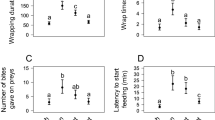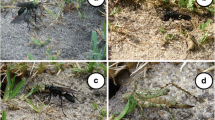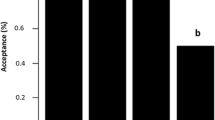Abstract
Scorpions are dominant predators in some environments. Nevertheless, most studies of predatory behavior in scorpions have focused on diet composition whereas some other relevant aspects, such as predatory strategy, have been poorly explored. Herein we evaluate the prey acceptance and predatory strategy of the scorpion Bothriurus bonariensis against sympatric prey with different defenses. As prey, we selected earwigs (Forficula cf. auricularia) which use pincer-like defensive appendages, hard-bodied isopods (Armadillium vulgare) known for their conglobation defensive strategy, soft bodied isopods (Porcellio cf. scaber), which secrete noxious substances as defense mechanisms, cockroaches with limited defensive mechanisms (Blatta cf. orientalis.) and spiders (Lycosa cf. poliostoma) which possess venomous fangs. Prey were offered to 21 adults of B. bonariensis in random order until all prey had been offered to all scorpions. Prey consumption and the number of attempts needed for capture were recorded. We also evaluated the effect of sting use on immobilization time as well as the prey capture strategies on the most consumed prey. We found that despite using a similar number of attempts for capturing all prey, spiders and armadillid isopods were less consumed than other prey. Immobilization times were longer for earwigs than for armadillid isopods and cockroaches. Scorpions used alternative predatory strategies against these aforementioned prey, although the stinger was used against all of them. These results show that scorpions are able to use different predatory strategies which might allow them to include prey with diverse defensive strategies in their diet.




Similar content being viewed by others
References
Albín A, Toscano-Gadea CA (2015) Predation among armored arachnids: Bothriurus bonariensis (Scorpions, Bothriuridae) versus four species of harvestmen (Harvestmen, Gonyleptidae). Behav Process 121:1–7. https://doi.org/10.1016/j.beproc.2015.10.003
Begon M, Townsend CR, Harper JL (2005) Ecology: From Individuals to Ecosystems, 4th Edition. Blackwell Publishing, Oxford
Bell WJ, Roth LM, Nalepa CA (2007) Cockroaches : ecology, behavior, and natural history. Johns Hopkins Univ Press, Baltimore
Benton TG (1991) The life history of Euscorpius flavicaudis. J Arachnol 19:105–110
Brueseke MA, Rypstra A, Walker SE (2001) Leg Autotomy in the Wolf Spider Pardosa milvina : A Common Phenomenon with Few Apparent Costs. Am Midl Nat 146:153–160
Bub K, Bowerman RF (1979) Prey capture by the scorpion Hadrurus arizonensis Ewing. J Arachnol 7:243–253
Casper G (1985) Prey capture and stinging behavior in the emperor scorpion, Pandinus imperator (Koch)(Scorpiones, scorpionidae). J Arachnol 13:277–283. https://doi.org/10.2307/3705310
Coelho P, Kaliontzopoulou A, Rasko M, van der Meijden A (2017) A “striking” relationship: scorpion defensive behaviour and its relation to morphology and performance. Funct Ecol 31:1390–1404. doi:https://doi.org/10.1111/1365-2435.12855
Cushing BS, Matherne A (1980) Stinger utilization and predation in the scorpion Paruroctonus boreus. Gt Basin Nat 40:193–195. https://doi.org/10.1111/een.12175
Daltry JC, Wuster W, Thorpe RS (1996) Diet and snake venom evolution. Nature 379:537–540
Dawkins R, Krebs JR (1979) Arms Races between and within Species. Proc R Soc B Biol Sci 205:489–511. https://doi.org/10.1098/rspb.1979.0081
Eastwood EB (1978) Notes on the scorpion fauna of the Cape. Part 3. Some observations on the distribution and biology of scorpions on Table Mountain. Ann South African Museum 74:229–248
Edmunds MC, Sibly RM (2010) Optimal sting use in the feeding behavior of the scorpion Hadrurus spadix. J Arachnol 38:123–125
Eisner T (1960) Defense mechanisms of arthropods. Ii. The chemical and mechanical weapons of an earwig. Psyche (Stuttg) 67:62–70
Fagan WF, Siemann E, Mitter C et al (2002) Nitrogen in Insects : Implications for Trophic Complexity and Species Diversification. Am Nat 160:784–802
Gabadinho A, Ritschard G, Mueller NS, Studer M (2011) Analyzing and Visualizing State Sequences in R with TraMineR. J Stat Softw 40:1–37. https://doi.org/10.18637/jss.v040.i04
Garcia LF, Franco V, Robledo-Ospina LE et al (2016) The Predation Strategy of the Recluse Spider Loxosceles rufipes (Lucas, 1834) against four Prey Species. J Insect Behav 29:515–526. https://doi.org/10.1007/s10905-016-9578-9
Gasch T, Schott M, Wehrenfennig C et al (2013) Multifunctional weaponry: The chemical defenses of earwigs. J Insect Physiol 59:1186–1193. https://doi.org/10.1016/j.jinsphys.2013.09.006
Gorvett H (1956) Tegumental glands and terrestrial life in woodlice. J Zool 126:291–314
Hadley NF, Williams SC, Williams C (1968) Surface Activities of Some North American Scorpions in Relation to Feeding. Ecology 49:726–734
Hasegawa M, Taniguchi Y (1996) Behavioral discrimination of prey with various defense mechanisms by the lizard Eumeces okadae. J Ethol 14:89–97. https://doi.org/10.1007/BF02348866
Hothorn T, Bretz F, Westfall P (2008) Simultaneous inference in general parametric models. Biom J 50:346–363. https://doi.org/10.1002/bimj.200810425
Jackson RR, Li D, Barrion AT, Edwards GB (1998) Prey-capture techniques and prey preferences of nine species of ant-eating jumping spiders (Araneae : Salticidae) from the Philippines. New Zeal J Zool 25:249–272. https://doi.org/10.1080/03014223.1998.9518155
Lehner P (1996) Handbook of Ethological Methods 2nd Edition. Cambridge University Press, Cambridge
Lira AFA, Santos AB, Silva NA, Martins RD (2017) Threat level influences the use of venom in a scorpion species, Tityus stigmurus (Scorpiones, Buthidae). Acta Ethol 3–7. https://doi.org/10.1007/s10211-017-0274-3
Lourenço W, Cuellar O (1995) Scorpions, scorpionism, life history strategies and parthenogenesis. J Venom Anim Toxins 1:51–62
Luiselli L, Angelici FM, Akani GC (2002) Comparative feeding strategies and dietary plasticity of the sympatric cobras Naja melanoleuca and Naja nigricollis in three diverging Afrotropical habitats. Can J Zool 80:55–63. https://doi.org/10.1139/z01-178
Machan L (1968) Spectral Sensitivity of Scorpion Eyes and the Possible Role of Shielding Pigment Effect. J Exp Biol 49:95–105
McCormick S, Polis GA (1982) Arthropods that prey on vertebrates. Biol Rev 57:29–58. https://doi.org/10.1111/j.1469-185X.1982.tb00363.x
Mccormick S, Polis GA (1990) Prey, predators and parasites. In: Polis GA (ed) The biology of scorpions. Stanford University Press, Stanford ress, pp 145–157
Morris JA, Akins JL (2009) Feeding ecology of invasive lionfish (Pterois volitans) in the Bahamian archipelago. Environ Biol Fish 86:389–398. https://doi.org/10.1007/s10641-009-9538-8
Mukherjee S, Heithaus MR (2013) Dangerous prey and daring predators: A review. Biol Rev 88:550–563. https://doi.org/10.1111/brv.12014
Nelson MK, Formanowicz DR (2005) Relationship between escape speed and flight distance in a wolf spider, Hogna carolinensis (Walckenaer 1805). J Arachnol 33:153–158. https://doi.org/10.1636/S03-37
Nisani Z, Dunbar SG, Hayes WK (2007) Cost of venom regeneration in Parabuthus transvaalicus (Arachnida: Buthidae). Comp Biochem Physiol - A Mol Integr Physiol 147:509–513. https://doi.org/10.1016/j.cbpa.2007.01.027
Olive CW (1980) Foraging specialization in orb-weaving spiders. Ecology 61(5):1133–1144
Olivero PA, Mattoni CI, Peretti AV (2017) Differences in mating behavior between two allopatric populations of a Neotropical scorpion. Zoology 123:71–78. https://doi.org/10.1016/J.ZOOL.2017.06.009
Oonincs DGAB, Dierenfeld ES (2011) An investigation into the chemical composition of alternative invertebrate prey. Zoo Biol 29:1–15. https://doi.org/10.1002/zoo.20382
Paris OH (1963) The Ecology of Armadillidium vulgare (Isopoda: Oniscoidea) in California Grassland: Food, Enemies, and Weather. Ecol Monogr 33:1–22. https://doi.org/10.2307/1948475
Patiño-Navarrete R, Piulachs M, Belles X et al (2014) The cockroach Blattella germanica obtains nitrogen from uric acid through a metabolic pathway shared with its bacterial endosymbiont. Biol Lett 10:20140407
Pekár S, Toft S (2015) Trophic specialisation in a predatory group: The case of prey-specialised spiders (Araneae). Biol Rev 90:744–761. https://doi.org/10.1111/brv.12133
Pekár S, Líznarová E, Řezáč M (2016) Suitability of woodlice prey for generalist and specialist spider predators: A comparative study. Ecol Entomol 41:123–130. https://doi.org/10.1111/een.12285
Pekár S, García LF, Viera C (2017) Trophic Niches and Trophic Adaptations of Prey-Specialized Spiders from the Neotropics: A Guide. In: Viera C, Gonzaga MO (eds) Behaviour and Ecology of Spiders: Contributions from the Neotropical Region. Springer International Publishing, Cham, pp 247–274
Pereira W, Elpino-Campos A, Del-Claro K, Machado G (2004) Behavioral repertory of the neotropical harvestman Ilhaia cuspidata (Opiliones: Gonyleptidae). J Arachnol 32:22–30
Polis GA, Due D (1985) The biology of Vaejovis littoralis Williams, an intertidal scorpion from Baja California, Mexico. J Zool 207:563–580
Polis GA, Farley RD (1979) Behavior and ecology of mating in the scorpion, Paruroctonus mesaensis Stahnke (Scorpionida : Vaejovidae). J Arachnol 7:33–46
Polis GA, McCormick SJ (1986) Scorpions, spiders and solpugids: predation and competition among distantly related taxa. Oecologia 71:111–116. https://doi.org/10.1007/BF00377328
Price JF, Shepard M (1978) Calosoma sayi and Labidura riparia predation on noctuid prey in soybeans and locomotor activity. Enviromental Entomol 7:653–656
R Core Team (2009) Language and Environment for Statistical Computing
Rein JO (1993) Sting use in two species of Parabuthus scorpions (Buthidae). J Arachnol 21:60–63. https://doi.org/10.2307/3705380
Rein JO (2003) Prey capture behavior in the East African scorpions Parabuthus leiosoma (Ehrenberg, 1828) and P. pallidus Pocock, 1895 (Scorpiones: Buthidae). Euscorpius 1895:1–8
Rezac M, Pekár S, Lubin Y (2008) How oniscophagous spiders overcome woodlouse armour. J Zool 275:64–71. https://doi.org/10.1111/j.1469-7998.2007.00408.x
Sarhan M, Sayed AB, Mostafa MA, Yasin AE (2013) Prey-capture behaviour of the Egyptian scorpion Scorpio maurus palmatus (Ehrenberg, 1828) (Scorpiones: Scorpionidae). Serket 13:201–210
Schenk D, Bacher S, Institut Z et al (2002) Functional response of a generalist insect predator to one of its prey species in the field. J Anim Ecol 71:524–531
Schultze W (1927) Biology of the large Philippine forest scorpion. Philipp J Sci 32(3):375–390
Shepard M, Waddill VAN, Kloft W (1973) Biology of the predaceous earwig Labidura riparia (Dermaptera : Labiduridae). Ann Entomol Soc Am 66:837–841
Stephens DW, Brown JS, Ydenberg RJ (2007) Foraging Behavior and Ecology. Princeton University Press, Princeton
Stewart AK (2006) Observations on prey-capture behavior of Androctonus crassicauda (Olivier, 1807) (Scorpiones: Buthidae) in northern Iraq. Euscorpius:1–9
Toft S, Li D, Mayntz D (2010) A specialized araneophagic predator’s short-term nutrient utilization depends on the macronutrient content of prey rather than on prey taxonomic affiliation. Physiol Entomol 35:317–327. https://doi.org/10.1111/j.1365-3032.2010.00746.x
Toscano-Gadea CA (2015) Biología reproductiva, gestación y cantidad de crías de seis especies de escorpiones de Uruguay(Scorpiones: Bothriuridae, Buthidae, Euscorpiidae). Bol Soc Zoológica del Uruguay 24:130–145
Toscano-Gadea CA, Costa FG (2006) Is Tityus uruguayensis (Buthidae) an araneophagic scorpion ? An experimental analysis of its predatory behaviour on spiders and insects. Bull Br Arachnol Soc 13:256–264
van der Meijden A, Coelho PL, Sousa P, Herrel A (2013) Choose Your Weapon : Defensive Behavior Is Associated with Morphology and Performance in Scorpions. PLoS One 8:e78955. https://doi.org/10.1371/journal.pone.0078955
van der Meijden A, Coelho P, Rasko M (2015) Variability in venom volume, flow rate and duration in defensive stings of five scorpion species. Toxicon 100:60–66
Van Valen L (1973) A new evolutionary law. Evol Theory 1:1–30
Viera C (2005) The prey capture behaviour of Metepeira gressa (Araneae, Araneidae) on mealworms, flies and ants. Rev Etol 7:53–62
Wall M, Shine R (2007) Dangerous food: Lacking venom and constriction, how do snake-like lizards (Lialis burtonis, Pygopodidae) subdue their lizard prey? Biol J Linn Soc 91:719–727. https://doi.org/10.1111/j.1095-8312.2007.00835.x
West-Eberhard MJ (2003) Developmental plasticity and evolution. Oxford Uninveristy Press.Inc
Wigger E, Kuhn-Nentwig L, Nentwig W (2002) The venom optimisation hypothesis: A spider injects large venom quantities only into difficult prey types. Toxicon 40:749–752. https://doi.org/10.1016/S0041-0101(01)00277-X
Yigit N, Benli M (2008) The venom gland of the scorpion species Euscorpius mingrelicus (Scorpiones: Euscorpiidae): Morphological and ultrastructural characterization. J Venom Anim Toxins Incl Trop Dis 14:466–480
Acknowledgements
We are indebted to Mario Clara and Marco Benamú for providing financial and logistic support. Gonzalo Desimone, Juan Zufiria, helped collect specimens. Carlos Toscano kindly confirmed the scorpion species. YS was financially supported by “Programma Atlante” grant provided by University of Ferrara. LFG is supported by National Research System (SNI-ANII) and CURE. ML was supported by the National Scolarships Programm (SNB-ANII) and CUR. AvdM is supported by a grant by Fundação para a Ciência e Tecnologia (FCT, Portugal) under the Programa Operacional Potencial Humano – Quadro de Referência Estratégico Nacional funds from the European Social Fund and Portuguese Ministério da Educação e Ciência (SFRH/BPD/101057/2014). Alvaro Laborda and the personal from the Entomology section (Facultad de Ciencias-Universidad de la República) kindly helped us with the identification of used prey.
Author information
Authors and Affiliations
Corresponding author
Rights and permissions
About this article
Cite this article
Simone, Y., Garcia, L.F., Lacava, M. et al. Predatory Versatility in Females of the Scorpion Bothriurus bonariensis (Scorpiones: Bothriuridae): Overcoming Prey with Different Defensive Mechanisms. J Insect Behav 31, 402–415 (2018). https://doi.org/10.1007/s10905-018-9677-x
Revised:
Accepted:
Published:
Issue Date:
DOI: https://doi.org/10.1007/s10905-018-9677-x




